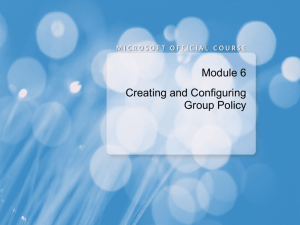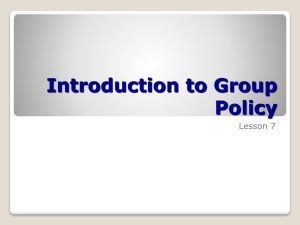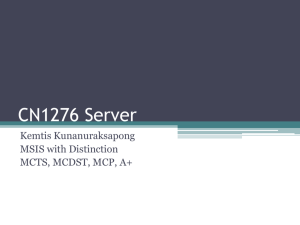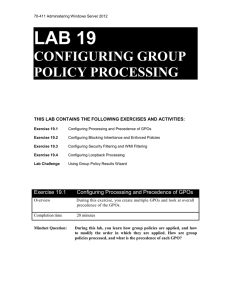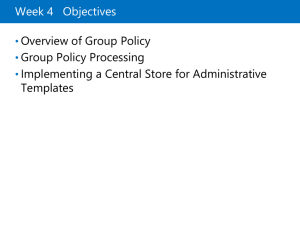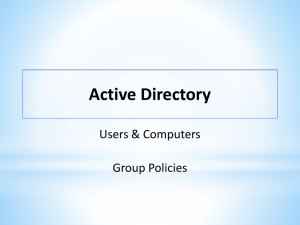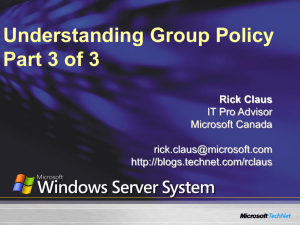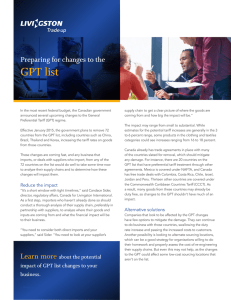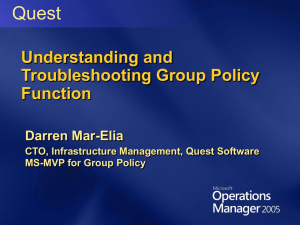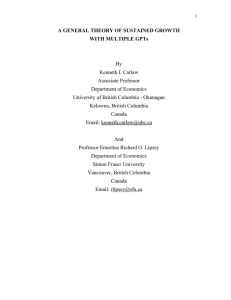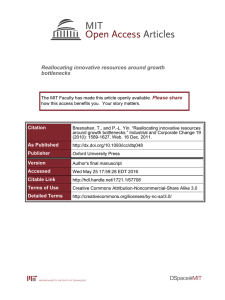MOAC294_Chapter07
advertisement
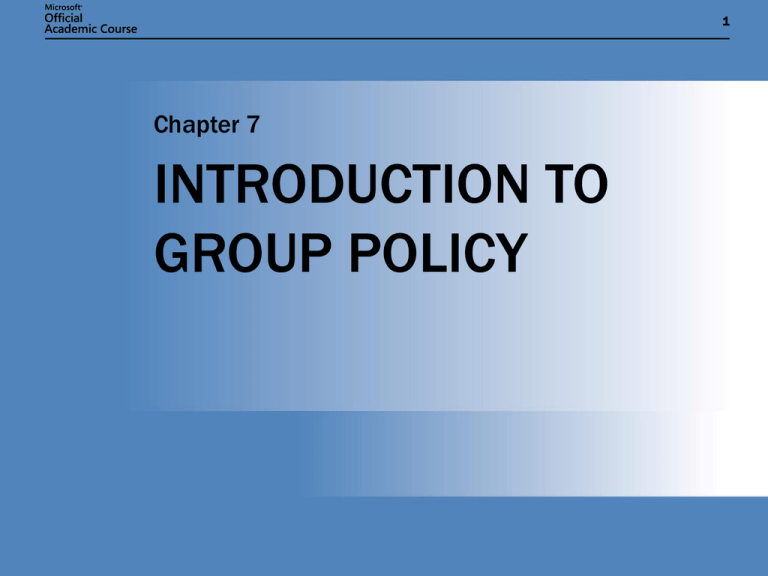
1 Chapter 7 INTRODUCTION TO GROUP POLICY Chapter 7: INTRODUCTION TO GROUP POLICY WHAT CAN YOU DO WITH GROUP POLICY? Control the user environment. Manipulate Start menu options, wallpaper, colors, and so on. Prevent users from using Control Panel. Control the computer settings. Configure DNS client settings. Configure the time server client computers use. Distribute software. Force software installation. Allow for easy optional software installation through Add/Remove Programs. 2 Chapter 7: INTRODUCTION TO GROUP POLICY POLICY SETTINGS Registry-based Software installations and repairs Folder redirection and offline storage Disk quotas Scripts Remote Installation Services Internet Explorer configuration Security 3 Chapter 7: INTRODUCTION TO GROUP POLICY LATENT APPLICATIONS OF GROUP POLICY Term describes a group of policies. Policies are not applied directly to groups. Policies can be linked to: Sites Domains OUs 4 Chapter 7: INTRODUCTION TO GROUP POLICY GROUP POLICY BENEFITS User benefits Access to files either offline or online. Consistent environment. Files are centrally backed up. Administrator benefits Centralized management of computer and user settings. Centralized application distribution. Centralized backup. Centralized security enforcement. 5 Chapter 7: INTRODUCTION TO GROUP POLICY UNDERSTANDING GROUP POLICY OBJECTS (GPOs) Local GPO Gpedit.msc (Local Computer Policy) Local Security Policy Non-Local Group Policy Objects Stored in Sysvol Linked to sites, domains, or OUs 6 Chapter 7: INTRODUCTION TO GROUP POLICY LOCAL GROUP POLICY 7 Chapter 7: INTRODUCTION TO GROUP POLICY GROUP POLICY CONTAINER OBJECT 8 Chapter 7: INTRODUCTION TO GROUP POLICY GROUP POLICY TEMPLATE (GPT) 9 Chapter 7: INTRODUCTION TO GROUP POLICY GPT STRUCTURE AND GPT.INI 10 Chapter 7: INTRODUCTION TO GROUP POLICY GROUP POLICY OBJECT EDITOR FOR DOMAINS AND OUS 11 Chapter 7: INTRODUCTION TO GROUP POLICY GROUP POLICY OBJECT EDITOR FOR SITES 12 Chapter 7: INTRODUCTION TO GROUP POLICY GROUP POLICY SETTINGS 13 Chapter 7: INTRODUCTION TO GROUP POLICY SOFTWARE SETTINGS 14 Chapter 7: INTRODUCTION TO GROUP POLICY WINDOWS SETTINGS 15 Chapter 7: INTRODUCTION TO GROUP POLICY ADMINISTRATIVE TEMPLATES 16 Chapter 7: INTRODUCTION TO GROUP POLICY 17 ADMINISTRATIVE TEMPLATE SETTING OPTIONS Chapter 7: INTRODUCTION TO GROUP POLICY 18 GROUP POLICIES AND THE ACTIVE DIRECTORY STRUCTURE Linked to site—Affects all users and computers in the site to which the policy is linked, regardless of domain membership Linked to domain—Affects all users and computers in the domain to which the policy is linked Linked to OU—Affects all users and computers in the OU to which the policy is linked Chapter 7: INTRODUCTION TO GROUP POLICY HOW GROUP POLICIES ARE PROCESSED Local-Site-Domain-OU (LSDOU) order. Different settings are merged. If there is a conflict on a particular setting: By default, the last policy applied wins. Exceptions: No Override, Block Policy Inheritance, and User Group Policy loopback processing mode. 19 Chapter 7: INTRODUCTION TO GROUP POLICY SCHOOL OF FINE ART AND GROUP POLICY APPLICATION 20 Chapter 7: INTRODUCTION TO GROUP POLICY MULTIPLE POLICIES LINKED TO A CONTAINER 21 Chapter 7: INTRODUCTION TO GROUP POLICY 22 GROUP POLICY PROCESSING AT STARTUP AND LOGON During computer startup, a list of GPOs for the computer is obtained. Computer settings are applied during startup. Startup scripts are run. Windows Logon prompt appears when step 3 completes. Upon successful validation of user, the user profile loads. A list of GPOs for the user is obtained. Logon scripts are run. The user interface appears. Chapter 7: INTRODUCTION TO GROUP POLICY NO OVERRIDE Ensures policy is applied, regardless of priority, hierarchy, inheritance blocking, or conflicting settings Configured on a per-policy basis 23 Chapter 7: INTRODUCTION TO GROUP POLICY BLOCK POLICY INHERITANCE Prevents policies from being inherited from higher levels in the Active Directory hierarchy Can be used at the Domain or OU level only—not per policy Cannot stop a policy marked as No Override 24 Chapter 7: INTRODUCTION TO GROUP POLICY 25 USER GROUP POLICY LOOPBACK PROCESSING MODE Maintains a specified user environment, no matter which user logs on Allows a computer account to apply User Settings last In merge mode, any conflicting settings are won by the loopback-enabled Group Policy. In replace mode, all user settings are set to whatever is configured in the loopback-enabled Group Policy. Chapter 7: INTRODUCTION TO GROUP POLICY SUMMARY Group Policy is used to control both User settings and Computer settings. GPOs can be linked to sites, domains, and OUs. GPOs have two parts: GPC and GPT. Default GPOs. Default Domain Policy Default Domain Controllers Policy Processing Order: L-S-D-OU. Exceptions: Block Policy Inheritance, No Override, and loopback. 26

